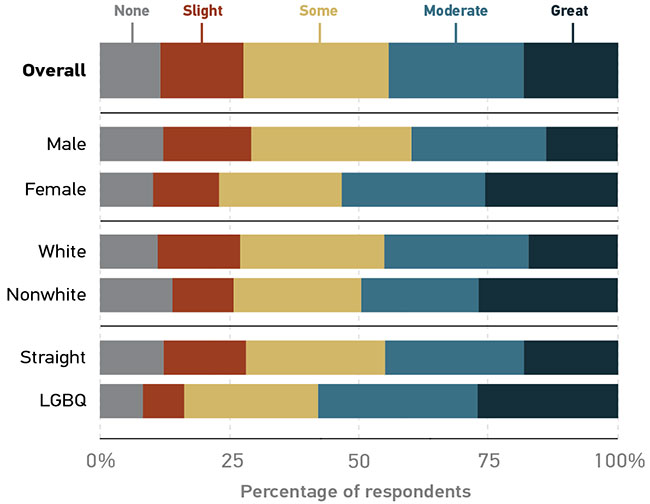DEI Training Benefits Underrepresented Groups
If IT leaders and managers were to create DEI professional development opportunities, how might higher education IT staff respond? Our results suggest that many would welcome it. Most of the respondents in our study (73%) believe that participating in a DEI workshop or training program (regardless of whether they have done so) would make at least some contribution to their professional growth in their current position (figure 4).

Our data also suggest that employees in underrepresented groups in higher education IT consider DEI programming especially beneficial: larger proportions of women, ethnic minorities, and members of the LGBQ community found more value for professional growth in DEI training than did their peers. These findings make sense when we consider that those not in a dominant social group may have experienced discrimination themselves and thus better understand and appreciate the goals for DEI programming. Members of underrepresented groups are also more likely to directly benefit from the positive application and outcomes of successful DEI training, which can foster a more equitable and inclusive workplace.
Research on different kinds of diversity policies has yielded similar results and demonstrates that race and gender can influence beliefs about workplace inequality. A 2019 study showed that nonwhites and women were significantly more supportive of diversity policies—which included training programs—than whites and men.1 The study also found that one's beliefs about inequality were predictors of support for workplace diversity policies; women and nonwhites more frequently than their counterparts believed discrimination causes inequalities. In addition, policies that are communicated in terms of addressing discrimination had more support than those that are framed with the goal of increasing diversity. As a result, DEI training programs that are designed to educate and increase awareness about gender, race, and class discrimination are effective ways to encourage more employee support,2 which could have greater impacts on professional growth.
Studies also suggest that voluntary training has more support by employees3 and can be more effective than mandated programs in decreasing bias and increasing the representation of some minority groups in the workplace.4 Mandates can be met with resistance, and research suggests that required participation can result in no improvement or declines in minority representation,5 and even increased hostility toward other groups.6 Voluntary DEI training allows employees to choose to participate, which can in turn decrease resistance and offer more space for cultural change in the workplace.
Notes
-
William J. Scarborough, Danny L. Lambouths III, and Allyson L. Holbrook, "Support of Workplace Diversity Policies: The Role of Race, Gender, and Beliefs about Inequality," Social Science Research 79 (March 2019): 194–210.
↩︎ -
Ibid.
↩︎ -
Ibid.
↩︎ -
Dobbin and Kalev, "Why Diversity Programs Fail."
↩︎ -
Ibid.
↩︎ -
Rohini Anand and Mary-Frances Winters, "A Retrospective View of Corporate Diversity Training from 1964 to the Present," Academy of Management Learning & Education 7, no. 3 (2008): 356–372.
↩︎